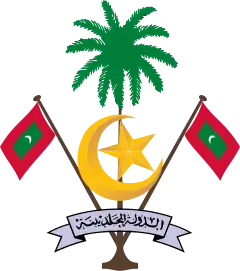Maldivian rufiyaa
The Maldivian rufiyaa (Dhivehi: ދިވެހި ރުފިޔާ; sign: Rf or .ރ; code: MVR) is the currency of the Maldives. The issuance of the currency is controlled by the Maldives Monetary Authority (MMA). The most commonly used symbols for the rufiyaa are MVR and Rf. The ISO 4217 code for Maldivian rufiyaa is MVR. The rufiyaa is subdivided into 100 laari.
| ދިވެހި ރުފިޔާ (Dhivehi) | |
|---|---|
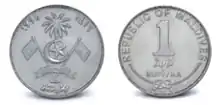 Rf. 1/- coin | |
| ISO 4217 | |
| Code | MVR (numeric: 462) before 1990: MVQ |
| Subunit | 0.01 |
| Unit | |
| Symbol | Rf, MVR, .ރ |
| Denominations | |
| Subunit | |
| 1⁄100 | laari |
| Banknotes | |
| Freq. used | Rf. 5/-, Rf. 10/-, Rf. 20/-, Rf. 50/-, Rf. 100/-, Rf. 500/- |
| Rarely used | Rf. 1,000/-, Rf. 5,000/- |
| Coins | |
| Freq. used | 50 laari, Rf. 1/-, Rf. 2/- |
| Rarely used | 1, 5, 10, 25 laari |
| Demographics | |
| User(s) | |
| Issuance | |
| Central bank | Maldives Monetary Authority |
| Website | www |
| Printer | De La Rue PLC |
| Website | www |
| Mint | Ministry of Finance |
| Website | www |
| Valuation | |
| Inflation | 2.8% |
| Source | The World Factbook, 2017 est. |
The name "rufiyaa" is derived from the Sanskrit रूप्य (rūpya, wrought silver). The midpoint of exchange rate is Rf. 12/85 per US dollar and the rate is permitted to fluctuate within a ±20% band, i.e. between Rf. 10/28 and Rf. 15/42 as of 10 April 2017.[1]
History
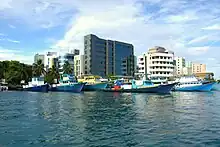
The earliest form of currency used in the Maldives was cowrie shells (Cypraea moneta) and historical accounts of travellers indicate that they were traded in this manner even during the 13th century. As late as 1344, Ibn Batuta observed that more than 40 ships loaded with cowry shells were exported each year. A single gold dinar was worth 400,000 shells.
During the 17th and 18th centuries, lārin[2] (parallel straps of silver wire folded in half with dyed Persian and Arabic inscriptions) were imported and traded as currency. This form of currency was used in the Persian Gulf, India, Ceylon and the Far East during this time. Historians agree that this new form of currency was most probably exchanged for cowry shells and indicates Maldives' lucrative trade with these countries. The first Sultan to imprint his own seal onto this currency was Ghaazee Muhammad Thakurufaanu al-Auzam. The seal was much broader than the wires hence it was barely legible.
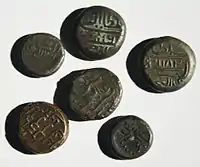
The first known of coins were introduced by Sultan Ibrahim Iskandar (1648–1687). Compared to the previous forms of money, these coins were much neater and minted in pure silver. The coins were minted in the capital city of Malé, a fact which it acknowledged on the reverse. The legend "King of Land and Sea, Iskandhar the Great" (Dhivehi: ކަނޑާއި އެއްގަމުގެ ރަސްގެފާނު، މަތިވެރި އިސްކަންދަރު) is found on the edge.
After this period, gold coins replaced the existing silver ones during the reign of Sultan Hassan Nooruddin in 1787. He used two different qualities of gold in his coins; one was called Mohoree and the other Baimohoree, of which the former is of higher value. How this gold was obtained is uncertain.
Throughout the nineteenth and early twentieth centuries, bronze coins were issued denominated in laari. Sultan Mohamed Imaadhudheen IV (1900–1904) introduced what historians believe to be the first machine struck coins, judging the superior quality of the engravements. His successor Sultan Mohamed Shamshudeen III (1904–1935) made the last of these coins, 1 and 4 laari denominations, which were struck in the United Kingdom by Heaton's Mint, Birmingham, England in 1913.
Following the end of coin production specifically for the Maldives, the Sultanate came to use the Ceylonese rupee. This was supplemented in 1947 by issues of banknotes denominated in rufiyaa, equal in value to the rupee. In 1960, coins denominated in laari, now worth one hundredth of the rufiyaa, were introduced.
In 1990, the formal ISO 4217 code was changed from MVQ (Maldive rupee) into MVR (rufiyaa).ISO 4217 Standard definition:
- "Data Standards, ISO 4217 - Currency Code Maintenance: Get the Correct Currency Code". www.six-group.com. SIX Group. 1 October 2022.
- "List One: Currency, fund and precious metal codes" (XLS). www.six-group.com. SIX Group. 23 September 2022.
- "List Two: Fund codes registered with the Maintenance Agency" (XLS). www.six-group.com. SIX Group. 29 August 2018.
- "List Three: Codes for historic denominations of currencies and funds" (XLS). www.six-group.com. SIX Group. 22 August 2018.
- "Overview Amendments" (XLSX). www.six-group.com. SIX Group. 23 September 2022.
Currency Sign
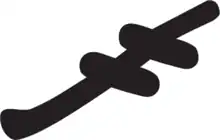
The currency symbol for Maldivian Rufiyaa was introduced to the public by MMA on 03 July 2022. The symbol represents letter “Ra” of Thaana script which also is the first letter in spelling “Rufiyaa” in Dhivehi. A parallel line is added to letter “Ra” to represent the arithmetic “equal” sign as used in various other currency symbols.
The symbol was designed by Mr. Hassan Shujau. It was chosen among 70 concept proposals received by MMA through a nationwide competition. The proposals were evaluated by an evaluation committee comprising members from MMA, Dhivehi Bahuge Academy and other areas of expertise.[3]
Coins
In early 1960, Sultan Mohamed Fareed I ordered coins from the Royal Mint in England. The new issue consisted of denominations of 1, 2, 5, 10, 25 and 50 laari. Unlike his predecessors, Sultan Fareed did not embellish his title on the coins; instead he used the National Emblem on the reverse side with the traditional title of the state (Arabic: الدولة المحلديبية, State of Maldives) and the denomination value on the obverse side. The currency was put into circulation in February 1961 and all the previously traded coins, with the exception of Shamshudeen III's 1 and 4 laari, were withdrawn from circulation on 17 June 1966.
The newly established central bank, the Maldives Monetary Authority (MMA), introduced the Rf. 1/- coin on 22 January 1983. The coin was made from steel clad copper nickel and was minted in West Germany. In 1984, a new series of coins was introduced which did not include the 2 laari denomination. In 1995, Rf. 2/- coins were introduced. Coins currently in circulation are 1 laari, 2 laari, 5 laari, 10 laari, 25 laari, 50 laari, Rf. 1/-, Rf. 2/-.
Banknotes
In 1945, the Majlis of the Maldives (Parliament) passed bill number 2/66 on the "Maldivian Bank Note". Under this law, banknotes for Rf. 1⁄2, Rf. 1/-, Rf. 2/-, Rf. 5/- and Rf. 10/- were printed and put into circulation on 5 September 1948.[4] In 1951, Rf. 50/- and Rf. 100/- banknotes were introduced.
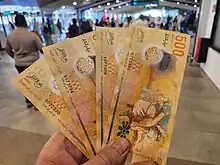
The current series of banknotes was issued in 1983 in denominations of Rf. 2/-, Rf. 5/-, Rf. 10/-, Rf. 20/-, Rf. 50/- and Rf. 100/-. Rf. 500/- banknotes were added in 1990, with the Rf. 2/- replaced by a coin in 1995.
In October 2015, the Maldives Monetary Authority issued a Rf. 5,000/- banknote in polymer to commemorate the 50th anniversary of independence, and issued a new family of banknotes in polymer that included a new denomination of Rf. 1,000/-. A Rf. 5/- banknote printed in polymer was revealed in May 2017 and was issued in July 2017. It was originally planned that this denomination was to be replaced by a coin of the same denomination, but public input convinced the Maldives Monetary Authority to go for the banknote.
Illustrations on the banknotes were done by Maizan Hassan Manik and Abbaas (Bamboo).
| 1983 series | |||||||
|---|---|---|---|---|---|---|---|
| Image | Value | Main colour | Dimensions | Description | Date of issue | ||
| Obverse | Reverse | Obverse | Reverse | ||||
| Rf. 5/- | Violet | 70 mm × 150 mm | Illustration of a bunch of coconuts and the "Dhivehi Odi" is common on the front of all banknotes in circulation. The coconut is widely used in the Maldives. The "Dhivehi Odi" built of coconut timber was used for inter island transport."Dhivehi Odi" is also a reference to "Kalhu'oh'fummi" the ship used by Muhammad Thakurufaanu and his brothers Ali and Hassan when they were fighting to liberate Maldives. | FISHING; The means of sustenance of the nation since time immemorial | 1983 | ||
| Rf. 10/- | Brown | ISLAND LIFE; A garland of widely scattered tiny islands has evolved a life of subsistence for the islanders | |||||
| Rf. 20/- | Pink | INNER HARBOUR MALE'; The centrifuge of commercial activity in the country | |||||
| Rf. 50/- | Blue | BAZAR IN MALE'; Buzzing with movement all day long | |||||
| Rf. 100/- | Green | "MEDHUZIYAARAIY"; A revered symbol of proud history | |||||
| Rf. 500/- | Red | ISLAMIC CENTRE AND MOSQUE; Emblazons the Islamic faith and unity of the nation | 1990 | ||||
| For table standards, see the banknote specification table. | |||||||
| 2015-2020 ("Ran Dhihafaheh") series | |||||||
|---|---|---|---|---|---|---|---|
| Image | Value | Main colour | Dimensions | Description | Date of issue | ||
| Obverse | Reverse | Obverse | Reverse | ||||
| Rf. 5/- | Gray-red | 150×70mm | Football players; fish; dancers | Conch shell | 2017 | ||
| Rf. 10/- | Yellow-brown | Men and women playing traditional drums; Toddy tapper | Traditional Maldivian drum | 2015
2018 | |||
| Rf. 20/- | Pink-violet | Jet airplane taking off from Velana International Airport; Fisherman and skipjack tuna; cowry shell (Cyprea moneta) | Dhoni | 2015
2020 | |||
| Rf. 50/- | Green | Men pulling boats from the beach onto the water; Seated boy reciting the Quran | Minaret of the Friday Mosque (Hukuru Miskiy) | 2015 | |||
| Rf. 100/- | Red | Group of locals in traditional attire; seated woman wearing traditional dress (Libaas), working on the neckline threading (Hiru) of a similar dress | Early Dhivehi scripture (Dambidū Lōmāfānu) | 2015
2018 | |||
| Rf. 500/- | Orange | Woman making ekels (Iloshi), traditionally used for brooms (Iloshi fathii); artisan carving wood using mallet and chisel | Traditional hand carved vase with lacquer work detailing | 2015 | |||
| Rf. 1,000/- | Blue | Manta rays (Manta alfredi), Green turtle (Chelonia mydas) | Whale shark (Rhincodon typus) | 2015 | |||
| For table standards, see the banknote specification table. | |||||||
| Current MVR exchange rates | |
|---|---|
| From Google Finance: | AUD CAD CHF CNY EUR GBP HKD JPY USD SGD THB INR |
| From Yahoo! Finance: | AUD CAD CHF CNY EUR GBP HKD JPY USD SGD THB INR |
| From XE.com: | AUD CAD CHF CNY EUR GBP HKD JPY USD SGD THB INR |
| From OANDA: | AUD CAD CHF CNY EUR GBP HKD JPY USD SGD THB INR |
References
- MMA announcement Archived 27 July 2011 at the Wayback Machine
- After Lar in modern day Iran where it was first minted Archived 6 October 2007 at the Wayback Machine
- "Currency Symbol for Maldivian Rufiyaa". mma.gov.mv. Maldives Monetary Authority. Retrieved 19 July 2023.
- Linzmayer, Owen (2012). "Maldives". The Banknote Book. San Francisco, CA: BanknoteNews.com.
- MMA (Dhivehi) Publication, 1983. ދިވެހި ރާއްޖޭގެ ފައިސާ (Maldivian Currency)
External links
- Currency in Circulation, Maldives Monetary Authority
- Maldives Rufiyaa Collection (1947–2018)
- Official Exchange Rates
- Banknotes of the Maldives
